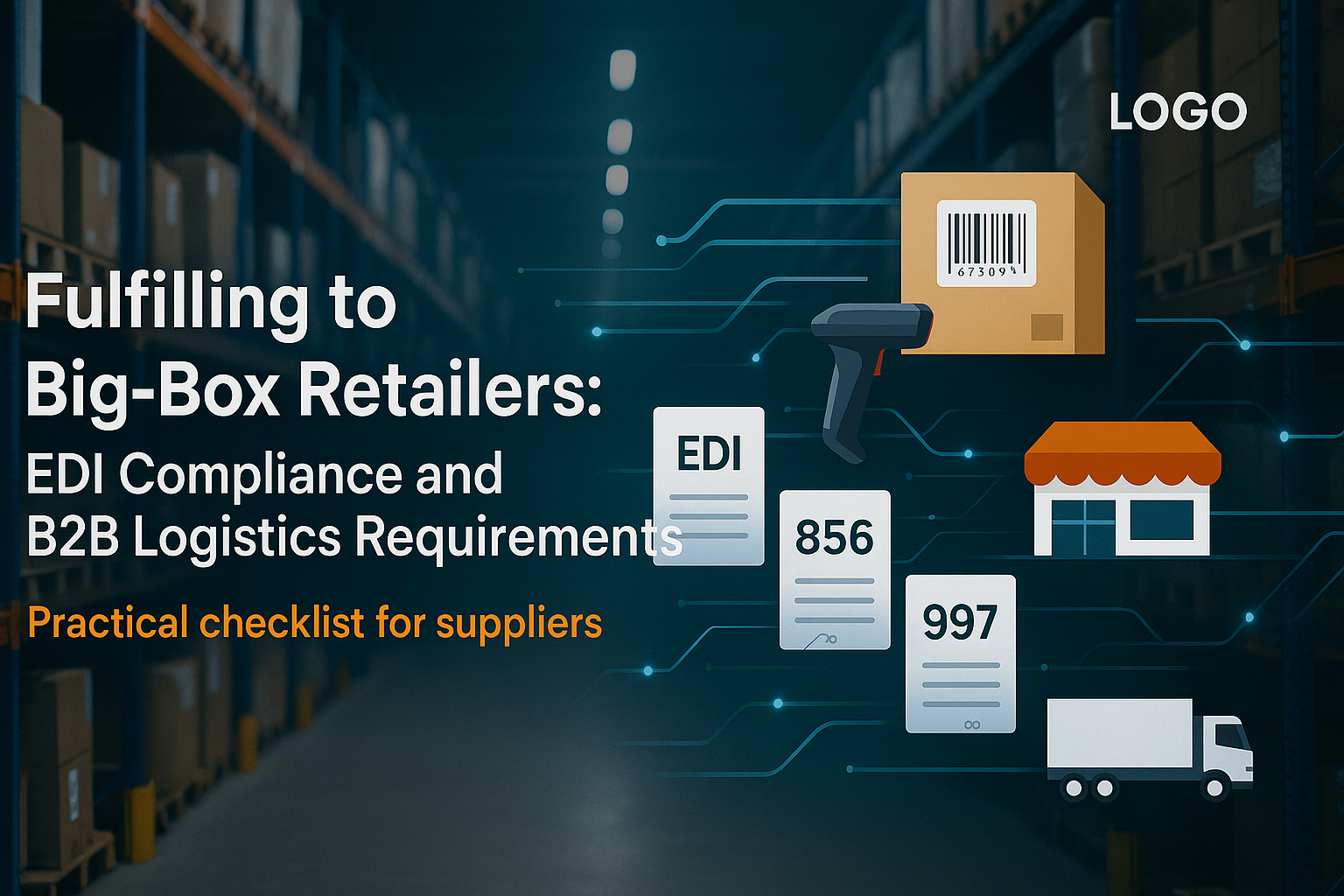Cracking the Code of Big-Box Retail: A Guide to EDI Compliance and B2B Fulfillment
Navigating the world of big-box retail can feel like stepping into a labyrinth of complex requirements, from strict routing guides to non-negotiable Electronic Data Interchange (EDI) protocols. For brands aiming to expand their reach and get their products on the shelves of giants like Walmart, Target, or Home Depot, understanding these B2B logistics requirements isn’t just an advantage—it’s an absolute necessity. A single misstep can lead to chargebacks, canceled orders, and damaged relationships.
This comprehensive guide will break down the essential components of B2B fulfillment for big-box retailers, focusing on the critical role of EDI compliance and offering actionable strategies to ensure your operations are seamless, efficient, and profitable. We’ll explore the differences between B2C and B2B fulfillment, dive into the specifics of EDI, and provide real-world examples to help you turn these complex requirements into a competitive edge.
—
B2C vs. B2B Fulfillment: A Tale of Two Logistical Worlds
While both B2C (Business-to-Consumer) and B2B (Business-to-Business) fulfillment involve picking, packing, and shipping products, their underlying processes, technologies, and scale are vastly different. Understanding this distinction is the first step toward mastering B2B logistics.
B2C Fulfillment: Speed and Volume
B2C fulfillment is all about speed and individual order volume. Think of it as a sprint: thousands of small, individual orders processed and shipped to a consumer’s doorstep. Key characteristics include:
- Small Order Sizes: Typically one to five items per order.
- Direct-to-Consumer: Shipments go directly to the end customer.
- Focus on Speed: Same-day or next-day shipping expectations.
- Technology: Optimized for high-volume order processing and individual tracking.
B2B Fulfillment: Precision and Compliance
In contrast, B2B fulfillment is a marathon of precision. It involves larger, consolidated shipments sent to a retail distribution center (DC) or store. The stakes are much higher, and the rules are non-negotiable. Key characteristics include:
- Large Order Sizes: Pallets or even full truckloads of products.
- Distribution Centers: Shipments are routed to DCs, not individual stores.
- Strict Compliance: Adherence to vendor guidelines, labeling requirements, and EDI.
- Partnership-Oriented: Focus on long-term, stable relationships with retail partners.
Neglecting these differences is a common pitfall. A B2C-optimized fulfillment system is simply not equipped to handle the complexities of B2B, often resulting in costly chargebacks and operational chaos.
—
Demystifying EDI: The Backbone of B2B Commerce
At the heart of B2B retail fulfillment is **Electronic Data Interchange (EDI)**. Put simply, EDI is a standardized electronic communication method that allows businesses to exchange documents—like purchase orders, invoices, and shipping notices—in a secure, computer-readable format. It replaces manual, paper-based processes, ensuring accuracy and efficiency.
For a brand to be a successful vendor for a big-box retailer, being EDI-compliant is non-negotiable. The retailer’s system expects specific information in a specific format at every stage of the order lifecycle. The most common EDI documents in B2B logistics include:
Essential EDI Documents and Their Roles
| EDI Document Number | Document Name | Purpose in the Supply Chain |
|---|---|---|
| EDI 850 | Purchase Order (PO) | The retailer sends this document to place an order. It contains all the details: item numbers, quantities, pricing, and shipping instructions. This is the starting point of the fulfillment process. |
| EDI 855 | Purchase Order Acknowledgment | You send this back to the retailer to confirm receipt and acceptance of the PO. It’s your way of saying, “We got the order and we’re ready to fulfill it.” |
| EDI 856 | Advance Ship Notice (ASN) | Arguably the most critical document. You send this before the shipment leaves the warehouse. It tells the retailer’s DC exactly what’s in the shipment, how it’s packed (carton count, pallet structure), and when it will arrive. Failure to send an accurate ASN is a leading cause of chargebacks. |
| EDI 810 | Invoice | Your billing document. It details the items shipped and the total amount due, matching the contents of the ASN and the original PO. |
Case Study: A Tale of Two Shipments
Imagine two brands, “Brand A” and “Brand B,” both shipping to a major retailer. Brand A handles its own fulfillment, but their team accidentally sends an EDI 856 (ASN) with an incorrect carton count. The retailer’s system flags the discrepancy upon arrival, resulting in a $500 chargeback for non-compliance and a delay in processing. Brand B, meanwhile, partners with a third-party logistics (3PL) provider like WarehouseTX that specializes in B2B logistics. Their automated system ensures every ASN is perfectly aligned with the physical shipment, guaranteeing seamless processing and no penalties. This is the power of EDI expertise.
—
Beyond EDI: Other Critical B2B Logistics Requirements
While EDI is paramount, it’s part of a larger ecosystem of B2B requirements. Ignoring any of these can be just as costly.
Routing Guides and Labeling Compliance
Every big-box retailer has a detailed **routing guide**—a bible of their specific shipping requirements. This guide dictates everything from pallet dimensions and stacking patterns to carton labeling and appointment scheduling. A common mistake is using generic shipping labels when the retailer requires specific **GS1-128 barcode labels** that contain detailed information about the carton’s contents. Mismatched labels lead to the shipment being rejected at the dock.
Appointment Scheduling and Delivery Windows
Big-box DCs operate on a strict appointment-only basis. A carrier showing up without a confirmed appointment will be turned away. Missed or late appointments often incur a fee and can delay your products from hitting the shelves.
Vendor-Managed Inventory (VMI)
Some retailers may require vendors to manage their own inventory levels within the retailer’s system, a model known as VMI. This requires sophisticated software and close collaboration to ensure product availability without overstocking.
—
How a 3PL Partner Can Simplify Your B2B Fulfillment
Given the complexity and high stakes of B2B logistics, many growing brands find that partnering with a specialized 3PL (Third-Party Logistics) provider is the most strategic and cost-effective solution. A 3PL with extensive B2B experience can provide a turnkey solution that handles all of the heavy lifting for you.
Key Benefits of Partnering with a B2B 3PL:
- EDI Integration & Automation: A reputable 3PL has pre-existing, tested integrations with all major retailers. They automate the EDI process, ensuring every document is accurate and sent on time, eliminating chargebacks.
- Expertise in Routing Guides: They are experts in interpreting and implementing strict retailer routing guides, from pallet configuration to labeling requirements. This ensures your shipments are always compliant.
- Scalability: As your brand grows, your 3PL can scale its operations to handle increased order volume and new retail partners without you needing to invest in new infrastructure or staff.
- Cost Savings: By consolidating shipments and leveraging their relationships with carriers, a 3PL can secure better freight rates and reduce shipping costs.
—
Frequently Asked Questions About B2B Fulfillment
What is a chargeback in B2B fulfillment?
A chargeback is a penalty fee a retailer imposes on a vendor for failing to comply with their B2B logistics requirements. This can be due to an inaccurate EDI document, incorrect labeling, a late shipment, or a packing error. Chargebacks can significantly erode your profit margins and damage your relationship with the retailer.
How can I ensure my products meet a retailer’s labeling requirements?
The best way is to carefully review the retailer’s routing guide, which outlines all labeling requirements, including barcode types (like GS1-128), label size, and placement. Partnering with a 3PL is a great way to ensure 100% compliance, as their systems are already configured to generate the correct labels automatically.
Is EDI software expensive?
EDI software can be a significant investment, with costs for implementation, integration, and ongoing maintenance. This is one of the primary reasons many brands choose to outsource to a 3PL. The 3PL has already made this investment, allowing you to access a fully compliant system without the high upfront costs or technical overhead.
Can I use the same inventory for both B2C and B2B orders?
Yes, you can. Many advanced fulfillment centers offer an omnichannel approach, where they manage a single pool of inventory for both B2C and B2B orders. This provides greater flexibility and reduces carrying costs. A skilled 3PL can seamlessly handle this, ensuring your inventory is optimized for all sales channels.
—
Conclusion: Your Path to Big-Box Success
Fulfilling orders for big-box retailers requires a strategic, detail-oriented approach. It’s not just about getting your products to the warehouse; it’s about speaking their language—a language of EDI documents, routing guides, and meticulous compliance. By understanding the core differences between B2C and B2B logistics, and by leveraging the expertise of a specialized partner, you can turn these complex requirements into a streamlined, automated process that fuels your brand’s growth. Are you ready to crack the code and unlock your brand’s full potential in the world of big-box retail?

